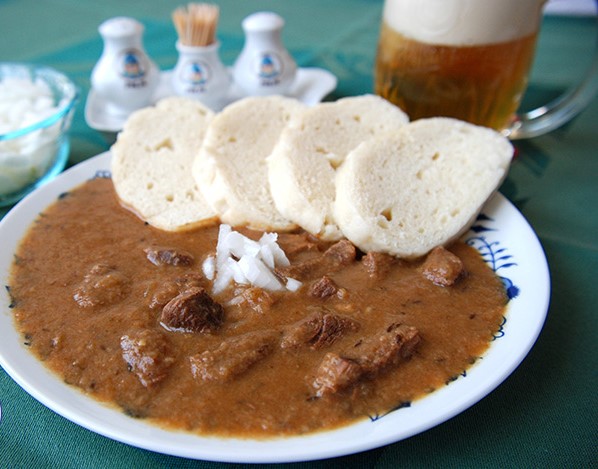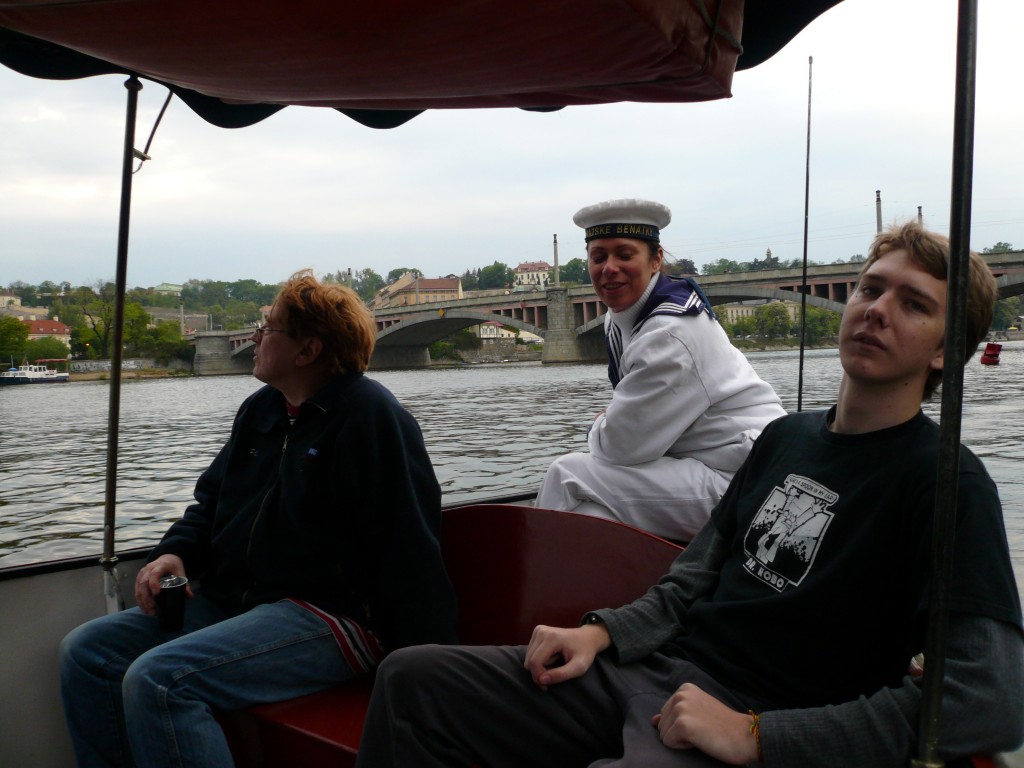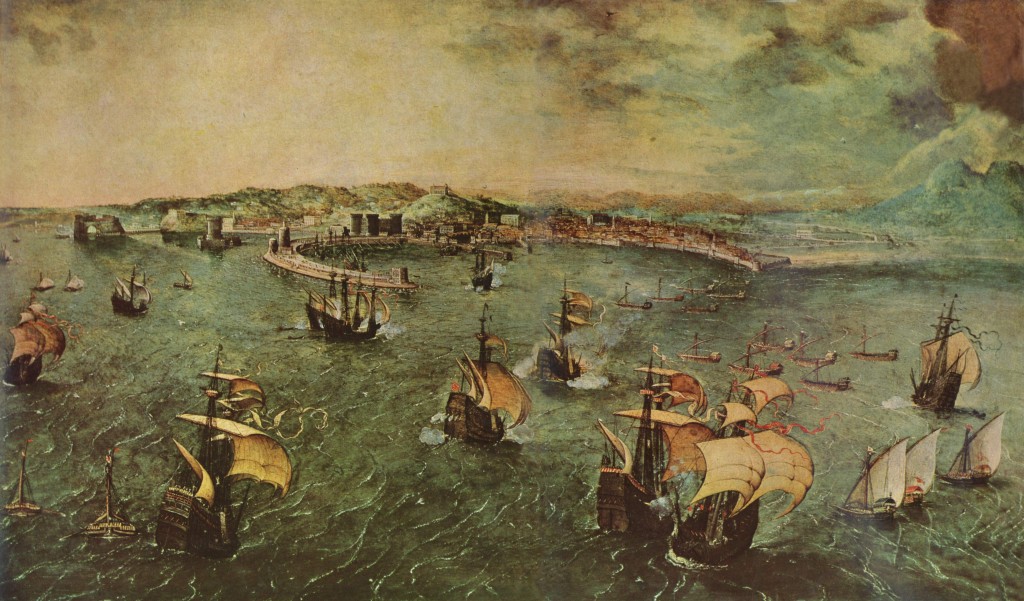 I was met at the airport by Isaac and Lourdes, who is Filip’s partner. We then picked up Filip from his work (he works in the film industry). We headed directly to the heart of the Old City (Josefov / Praha 1). Filip was eager to feed us a very traditional Bohemian meal, and we were equally eager to eat one. For me, this was a Bohemian-style goulash, quite different from the Hungarian, and for Isaac it was a cutlet in sweet peppercorn sauce. Both were accompanied by wondrous dumplings, which Filip instructed us not to eat “like and American”, i.e., as if they were pieces of bread. They are properly to be cut and eaten with a fork, like potatoes.
I was met at the airport by Isaac and Lourdes, who is Filip’s partner. We then picked up Filip from his work (he works in the film industry). We headed directly to the heart of the Old City (Josefov / Praha 1). Filip was eager to feed us a very traditional Bohemian meal, and we were equally eager to eat one. For me, this was a Bohemian-style goulash, quite different from the Hungarian, and for Isaac it was a cutlet in sweet peppercorn sauce. Both were accompanied by wondrous dumplings, which Filip instructed us not to eat “like and American”, i.e., as if they were pieces of bread. They are properly to be cut and eaten with a fork, like potatoes.
Lourdes, I think, has been very good for Filip. He is a strong-willed man, who occasionally gets stubborn or crabby. Lourdes brooks no nonsense, but she is obviously easy-going in temperament. Throw in beauty, intelligence, and spontaneously gracious manners, and you can see that he has hit the jackpot. Filip has often written or talked to me about her, and I can see that she has made him happier. She is from Madrid, so they began by communicating in English, but now Filip is fluent in Spanish, and she in Czech. Mostly, they speak Spanish together, though through the next few days, they spoke English for our benefit.
And those five days were very good ones, indeed. They culminated in an evening when we went through three bottles of red wine, and the conversation covered everything from Cervantes to dead baby jokes, and was repeatedly punctuated with laughter. A very, very fine evening. But we had many conversations before that, in many places, over dinner in a strange place decorated like the Flintstones and offering prehistoric fare, walking along the shore of the Vltava (Moldau), or in the dark streets of districts seldom seen by tourists. We were given the royal treatment. Sometimes we were being shown around specific sites, as when Filip walked us, late at night, to the Vyšehrad, a part of Prague older than the Castle or the Josefov. It was built in the 10th century, and was said to be the first habitation in Prague. When the Přemyslid dynasty settled on the current site of Prague Castle, the two castles maintained opposing spheres of influence for two hundred years, until the Emperor Charles IV moved the seat of the Bohemian kingdom to Prague Castle. The fortifications command a splendid view over the river, along steep cliffs, but they don’t seem to attract tourists. When Holy Roman Emperor Charles IV began to build the Prague Castle in its current dimensions (in the early 14th century), Vyšehrad was abandoned as a royal home. But it saw action as the site of battles between Hussites and Catholic crusaders. There is a massive church crowning the hill, but nearby, Filip showed us a much more interesting, but tiny Romanesque structure of the 11th century, the Rotunda of St. Martin.
Earlier that same night, we experienced one of those divine aesthetic moments that I associate with walking in Prague. The four of us had been examining the poorest district in the city, an area of run-down blocks of flats inhabited mostly by Roma. Only a few blocks from it is a small 18th century house, tucked into a cubbyhole along a hillside. It’s there that Mozart composed Don Giovanni. We walked up to the house. The air was evening air, perfectly balanced between warm and cool. There were lights in the windows, and from them, we could hear a pianist and singer performing one of Mozart’s comic arias, those little bits of fluff that he composed now and then, which drift on the night air like a champagne bubble.
 Filip even arranged for us to cross the Vltava in a small boat, poking into some side canals, and under the single arch that remains, well hidden, of the original stone bridge that preceded the Charles Bridge [Karlův most]. But at other times, Isaac and I walked the city together, and we looked through Prague Castle and the National Gallery without our hosts. Those who are curious can easily look it up. The Castle is too well known to need any description. We entered St. Vitus’ Cathedral, and the catacombs below it. But we also took time for castle portion of the National Gallery [Národní galerie v Praze]. Much of it demonstrated that, when the old Bohemian royalty went shopping for pictures in Italy, they could only pick up works by second-string masters that had not already been snapped up by more powerful patrons of the arts. But the gallery contains first-rate Bohemian art from several periods, and some fine German and Flemish works, including some good ones by Dürer and some amazing Brueghels.
Filip even arranged for us to cross the Vltava in a small boat, poking into some side canals, and under the single arch that remains, well hidden, of the original stone bridge that preceded the Charles Bridge [Karlův most]. But at other times, Isaac and I walked the city together, and we looked through Prague Castle and the National Gallery without our hosts. Those who are curious can easily look it up. The Castle is too well known to need any description. We entered St. Vitus’ Cathedral, and the catacombs below it. But we also took time for castle portion of the National Gallery [Národní galerie v Praze]. Much of it demonstrated that, when the old Bohemian royalty went shopping for pictures in Italy, they could only pick up works by second-string masters that had not already been snapped up by more powerful patrons of the arts. But the gallery contains first-rate Bohemian art from several periods, and some fine German and Flemish works, including some good ones by Dürer and some amazing Brueghels.
Isaac, luckily got to see his first view of the Charles Bridge at the perfect time, at twilight, when it still preserves some of the atmosphere that has gained its place in poetry and fiction. When we crossed it again in daylight, it was jammed with the usual throng of tourists and hawkers.
This brings me to a subject that Filip has often mentioned to me with distinct resentment: the plague of tourists in Prague. Now, tourists are expected in any historic city, and in the right circumstances and proportions, they are a good thing. But in the present situation, they are definitely not a good thing.
Prague is a treasure house of architecture. It suffered only one accidental bombing raid during World War Two, so its historic buildings are not, as in most European cities, mostly reconstructed. The city contains wonderful historic churches, monuments, bridges, and buildings dating from the 14th century onwards. But they are only the tip of the iceberg. The ordinary domestic buildings, from the time of the late Austro-Hungarian Empire, and the time of the Czechoslovak Republic of 1919–1939, maintained an extraordinarily high aesthetic standard. There are superb examples of Art-Nouveau and Art Deco everywhere. The poverty and neglect of the Communist era left many of them in a wretched state of disrepair, but it is merely a matter of new plaster, paint, plumbing and wiring to restore them to their original splendour. When I was last here, five years ago, only about a tenth of the buildings had been restored. Now it looks more like half. Some new buildings have been added, but I did not see many cases where these clashed or seemed wrong. The old buildings that remain in bad condition tend to be owned by absentee landlords. After the revolution, many properties were restored to their original owners, in many cases elderly people who live in other countries, or their heirs. Many of these distant owners have no idea what to do with such properties. This problem will sort itself out with time, but it leaves some embarrassing blots on almost every street.
Because of its visual charm, literary and musical associations, and lower consumer prices than in most of Western Europe, easily accessible Prague began to be “discovered” by tourists in the early 1990’s. The romance of the “velvet revolution” also spread its fame. Five years ago, the trickle of tourists had become a flood. Now, I can see, it is a deluge. The chamber-of-commerce boosterism of the city’s administration has responded with a spectacle of tasteless exploitation that would embarrass anyone with common sense. The ancient, winding streets are now nothing but a labyrinth of tacky tourist shops. Nothing remains functioning in the old city center that resembles the normal activities of a city. There are only souvenir shops, bars and restaurants catering specifically to foreigners, and high-fashion stores for international shoppers. Czechs avoid the place. The big names of Prague’s culture — Mozart, Kafka, Mucha — are shouted out from blaring speakers and blinking signs (though, curiously, Dvořák doesn’t seem to figure very prominently). Every effort is made to shake as much cash out of pockets as possible.
The most embarrassing exploitation surrounds the medieval Jewish quarter. It contains synagogues and a cemetery of great historical importance. Most of Prague’s sophisticated Jewish population either fled or perished in the Holocaust. The legend of the Golem originated in Prague’s medieval ghetto. When I was last there, these things were pointed out, but not yet excessively ballyhooed. Now they are treated some kind of creepy Disneyland, and even the poor Golem is thrown at you more or less like Spiderman.
With tourism, the question is “how much is enough”. A city has to function as a city for its citizens first, not merely exist to attract visitors. Hordes of British football fans descending on the city to get drunk and layed at bargain prices does not constitute a tribute ot its history and culture. And sooner or later, rising prices will lead to the collapse of such an artificial “industry”. Tourists are already “discovering” Bucharest and other cheap, atmospheric places. The boosters will have to redouble the vulgarity in a futile attempt to retain them. By then, the city will be so renowned for its tastelessness, that “magic Prague” will be a sour joke.
I hope that someone with good sense comes into power in this city, and leads it away from that disastrous path, because there really is a “magic Prague” for those with the eyes to see it.

0 Comments.